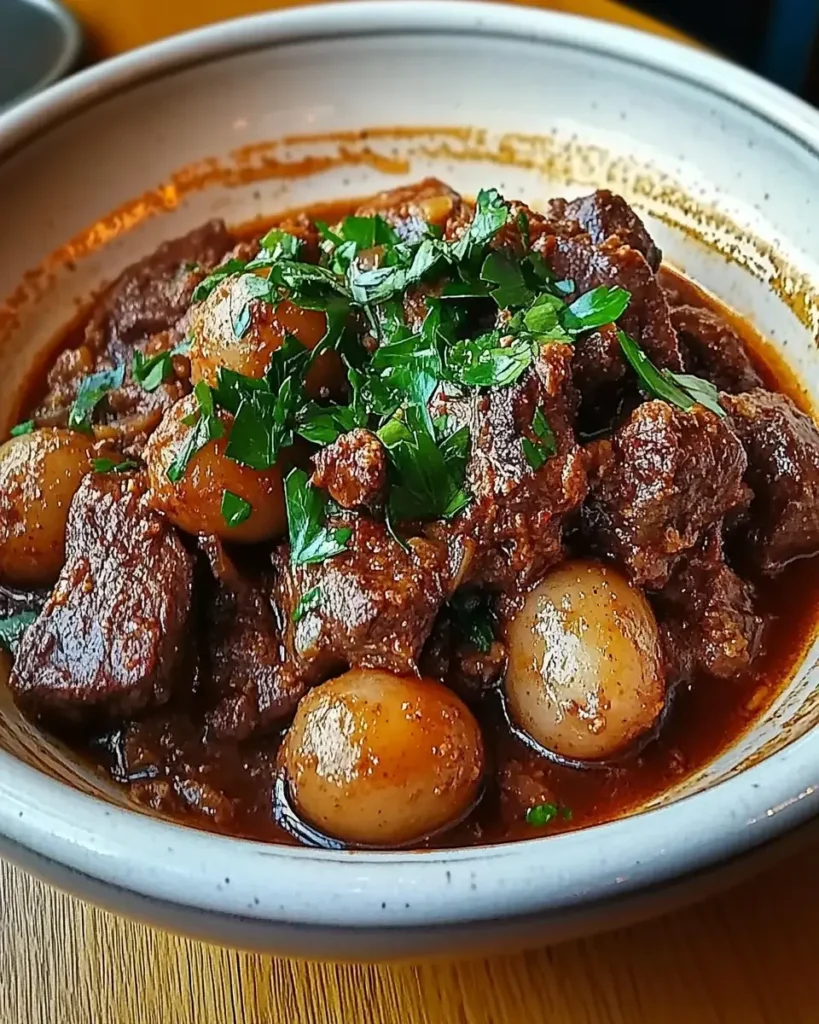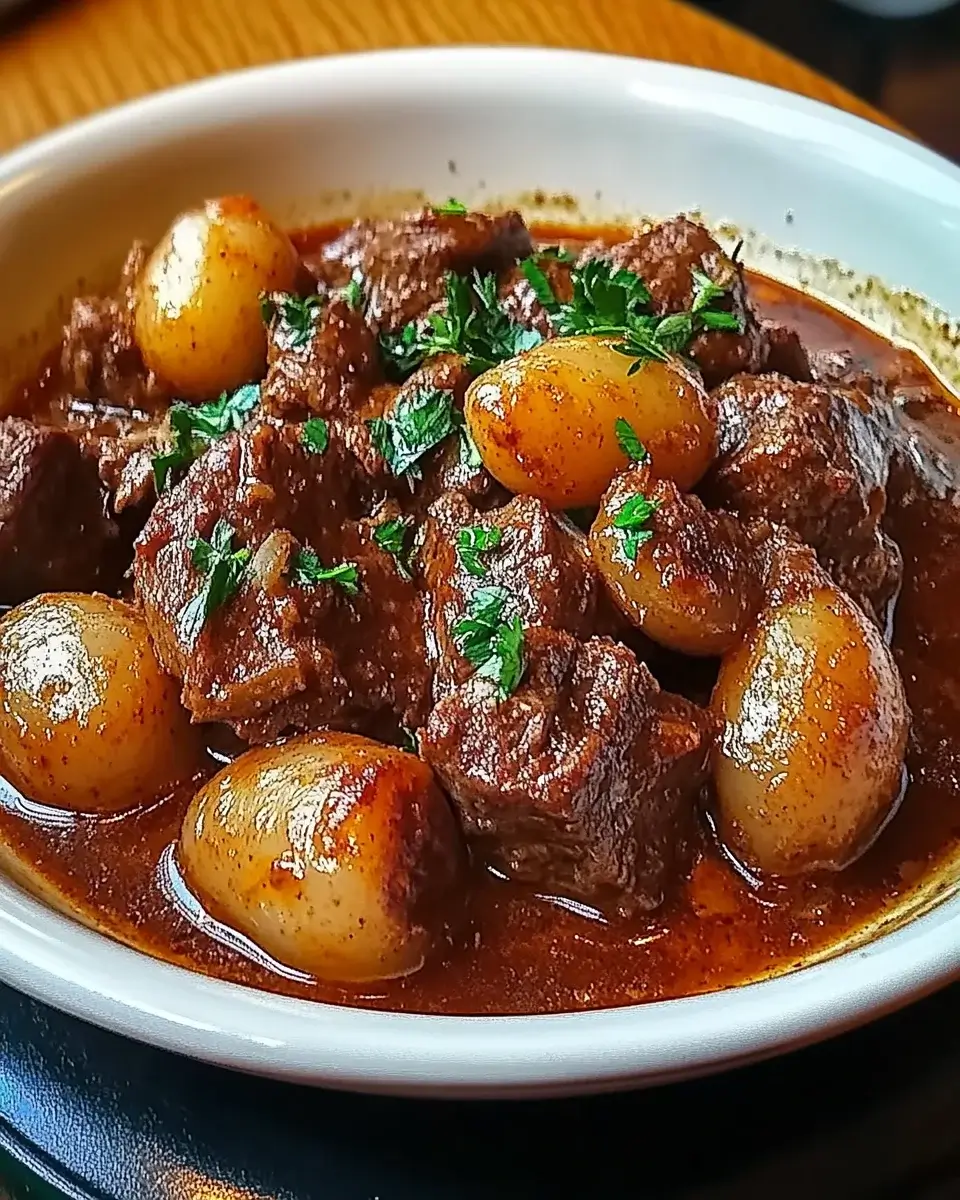Introduction to Greek Beef Stew Recipe
Greek cuisine is known for its rich flavors and wholesome ingredients. One dish that stands out is the Greek Beef Stew, or Stifado. This hearty meal is not just a feast for the taste buds; it also tells a story of tradition and culture. In this section, we will explore what makes this dish unique and its significance in Greek culture.
What Makes Greek Beef Stew Unique?
Greek Beef Stew is unique for several reasons. First, it combines tender beef with a variety of aromatic spices. The use of cinnamon and oregano gives it a warm, inviting flavor. Additionally, the inclusion of pearl onions and Kalamata olives adds a delightful texture and taste. The slow cooking process allows the flavors to meld beautifully, creating a rich sauce that is perfect for soaking up with bread or serving over rice.
Another aspect that sets this stew apart is its versatility. While the traditional recipe uses beef, you can easily substitute lamb or even chicken for a different twist. This adaptability makes it a favorite among many families, as everyone can enjoy their preferred protein. Plus, the stew can be made in a pot or a slow cooker, making it accessible for all cooking styles.
The Cultural Significance of Greek Beef Stew
Greek Beef Stew holds a special place in Greek culture. It is often served during family gatherings and festive occasions. The dish symbolizes warmth and hospitality, reflecting the Greek way of life. Sharing a meal is an important tradition in Greece, and Stifado is a dish that brings people together.
Moreover, this stew is often associated with the Mediterranean diet, which emphasizes fresh ingredients and healthy fats. The use of olive oil, lean meat, and vegetables makes it not only delicious but also nutritious. This aligns with the Greek philosophy of enjoying food in moderation and appreciating the flavors of nature.
In conclusion, the Greek Beef Stew is more than just a meal; it is a celebration of culture, family, and tradition. Whether you are enjoying it at a festive gathering or a cozy dinner at home, this dish is sure to warm your heart and satisfy your appetite.
Ingredients for Greek Beef Stew Recipe
To create a delicious Greek Beef Stew, you’ll need a variety of fresh and flavorful ingredients. Each component plays a vital role in building the rich taste that this dish is known for. Below is a list of the essential ingredients you’ll need to gather before you start cooking.
- 2 pounds beef chuck: Cut into 1-inch cubes for tenderness.
- 2 tablespoons olive oil: This adds healthy fat and flavor.
- 1 large onion: Chopped to provide sweetness and depth.
- 4 cloves garlic: Minced for a fragrant kick.
- 2 cups beef broth: This forms the base of the stew.
- 1 cup red wine: Adds richness and complexity.
- 1 can (14.5 ounces) diced tomatoes: For acidity and moisture.
- 2 tablespoons tomato paste: Enhances the tomato flavor.
- 2 teaspoons dried oregano: A classic herb in Greek cooking.
- 1 teaspoon ground cinnamon: Adds warmth and a hint of sweetness.
- 1 teaspoon sugar: Balances the acidity of the tomatoes.
- 1 bay leaf: Infuses the stew with aromatic flavor.
- Salt and pepper: To taste, enhancing all the flavors.
- 1 pound pearl onions: Peeled for a sweet, tender bite.
- 1/2 cup pitted Kalamata olives: For a briny contrast.
- Fresh parsley: Chopped, for garnish and freshness.
Gathering these ingredients will set you on the right path to making a delightful Greek Beef Stew. Each item contributes to the overall flavor and texture, ensuring a satisfying meal for you and your loved ones.
Step-by-Step Preparation of Greek Beef Stew Recipe
Now that you have all your ingredients ready, it’s time to dive into the cooking process. Each step is crucial for creating a flavorful Greek Beef Stew. Follow these simple instructions to ensure your dish turns out perfectly.
Step 1: Preparing the Ingredients
Before you start cooking, it’s important to prepare all your ingredients. Begin by cutting the beef chuck into 1-inch cubes. This size helps the meat cook evenly and become tender. Next, chop the large onion and mince the garlic cloves. Finally, peel the pearl onions and set everything aside. Having your ingredients prepped will make the cooking process smoother and more enjoyable.
Step 2: Browning the Beef
In a large pot or Dutch oven, heat the olive oil over medium-high heat. Once the oil is hot, add the beef cubes in batches. Make sure not to overcrowd the pot, as this can prevent proper browning. Brown the beef on all sides, which should take about 5-7 minutes. This step is essential as it locks in the flavors. Once browned, remove the beef from the pot and set it aside on a plate.
Step 3: Sautéing the Vegetables
In the same pot, add the chopped onion. Sauté it for about 5 minutes until it becomes translucent. This process enhances the sweetness of the onion. After that, add the minced garlic and cook for another minute. The aroma will fill your kitchen, making it hard to resist! This step builds a flavorful base for your stew.
Step 4: Combining Ingredients
Return the browned beef to the pot with the sautéed onions and garlic. Now, it’s time to add the rest of the ingredients. Pour in the beef broth and red wine, followed by the diced tomatoes and tomato paste. Sprinkle in the dried oregano, ground cinnamon, sugar, bay leaf, salt, and pepper. Stir everything together until well combined. This mixture is where the magic happens, as all the flavors meld together.
Step 5: Simmering the Stew
Bring the stew to a gentle simmer. Once it starts bubbling, cover the pot and reduce the heat to low. Let it simmer for 1.5 to 2 hours. This slow cooking process allows the beef to become tender and absorb all the delicious flavors. Remember to stir occasionally to prevent sticking and ensure even cooking.
Step 6: Final Touches
In the last 30 minutes of cooking, add the peeled pearl onions and Kalamata olives to the pot. These ingredients will add sweetness and a briny contrast to the stew. Continue to simmer until the pearl onions are tender. Before serving, don’t forget to remove the bay leaf. Garnish your Greek Beef Stew with freshly chopped parsley for a pop of color and freshness. Your hearty meal is now ready to be enjoyed!
Variations of Greek Beef Stew Recipe
While the traditional Greek Beef Stew is a beloved classic, there are many ways to put a personal twist on this dish. Whether you want to experiment with alternative ingredients or try different cooking methods, these variations can help you create a unique version of this hearty meal. Let’s explore some exciting options!
Alternative Ingredients
One of the best things about the Greek Beef Stew is its versatility. You can easily swap out certain ingredients to suit your taste or dietary needs. Here are some alternative ingredients you might consider:
- Lamb: For a richer flavor, substitute beef with lamb. It pairs beautifully with the spices and adds a unique twist.
- Vegetables: Add more vegetables like carrots, bell peppers, or mushrooms for extra nutrition and flavor. These can be added during the sautéing step.
- Herbs: Experiment with fresh herbs like thyme or rosemary instead of dried oregano. Fresh herbs can elevate the dish with their vibrant flavors.
- Different Olives: If you prefer a milder taste, try using green olives instead of Kalamata olives. They will still provide a nice briny touch.
- Spices: For a spicier kick, add a pinch of red pepper flakes or a dash of smoked paprika. This can give your stew a delightful warmth.
These alternative ingredients can help you customize your Greek Beef Stew to your liking, making it a dish that everyone can enjoy.
Different Cooking Methods
In addition to ingredient variations, you can also explore different cooking methods to prepare your Greek Beef Stew. Here are a few options:
- Slow Cooker: For a hands-off approach, use a slow cooker. Simply brown the beef and sauté the vegetables, then transfer everything to the slow cooker. Cook on low for 6-8 hours for tender, flavorful results.
- Pressure Cooker: If you’re short on time, a pressure cooker can significantly reduce cooking time. Cook the stew for about 30-40 minutes under high pressure for a quick and delicious meal.
- Oven-Braised: After browning the beef and sautéing the vegetables, transfer the pot to a preheated oven at 325°F (160°C). Let it braise for 2-3 hours for a rich and deeply flavored stew.
These cooking methods can help you achieve different textures and flavors in your Greek Beef Stew, making it a versatile dish for any occasion.
Cooking Note for Greek Beef Stew Recipe
When preparing your Greek Beef Stew, there are a few important cooking notes to keep in mind. These tips will help ensure that your dish turns out perfectly every time. Understanding the cooking process can make a big difference in flavor and texture.
First, the quality of your beef is crucial. Choose a good cut, like beef chuck, which is known for its tenderness when slow-cooked. This cut has enough fat to keep the meat juicy and flavorful. If you can, opt for grass-fed beef, as it often has a richer taste.
Next, don’t rush the browning process. Taking the time to brown the beef properly adds depth to the stew. This step creates a beautiful crust on the meat, enhancing the overall flavor. Remember, patience is key!
Also, consider the simmering time. The longer you let the stew simmer, the more tender the beef will become. If you have the time, aim for the full 2 hours. This slow cooking allows the flavors to meld beautifully, resulting in a rich and hearty stew.
Lastly, taste as you go! Adjust the seasoning to your preference. You might find that a little extra salt or a dash of pepper can elevate the dish. Each ingredient plays a role, so don’t hesitate to tweak it to suit your taste.
By following these cooking notes, you’ll be well on your way to creating a delicious Greek Beef Stew that your family and friends will love. Enjoy the process and the wonderful aromas that fill your kitchen!
Serving Suggestions for Greek Beef Stew Recipe
Once your Greek Beef Stew is ready, it’s time to think about how to serve it. The right side dishes and beverages can enhance the meal, making it even more enjoyable. Here are some ideal pairings to consider when serving your delicious stew.
Ideal Side Dishes
When it comes to side dishes, you want to complement the rich flavors of the Greek Beef Stew. Here are some great options:
- Crusty Bread: A loaf of fresh, crusty bread is perfect for soaking up the flavorful sauce. Consider serving a rustic sourdough or a traditional Greek bread.
- Rice: Serve the stew over a bed of fluffy rice. This adds a nice texture and helps balance the hearty stew.
- Greek Salad: A refreshing Greek salad with tomatoes, cucumbers, olives, and feta cheese can provide a light contrast to the rich stew.
- Roasted Vegetables: Roasted seasonal vegetables, such as zucchini, bell peppers, and carrots, can add color and nutrition to your meal.
- Mashed Potatoes: Creamy mashed potatoes can be a comforting side that pairs well with the stew’s robust flavors.
These side dishes not only enhance the meal but also add variety to your dining experience. Choose one or more to create a well-rounded plate.
Pairing with Beverages
Choosing the right beverage can elevate your meal even further. Here are some beverage pairings that go well with Greek Beef Stew:
- Red Wine: A glass of red wine, such as a robust Cabernet Sauvignon or a fruity Merlot, complements the flavors of the stew beautifully.
- Greek Beer: For a local touch, consider serving a Greek beer like Mythos or Fix. These light beers can refresh your palate.
- Sparkling Water: If you prefer a non-alcoholic option, sparkling water with a slice of lemon can cleanse your palate and enhance the meal.
- Herbal Tea: A warm cup of herbal tea, such as chamomile or mint, can be a soothing way to end your meal.
By thoughtfully selecting side dishes and beverages, you can create a delightful dining experience that highlights the flavors of your Greek Beef Stew. Enjoy your meal with family and friends, and savor every bite!

Tips for Perfecting Your Greek Beef Stew Recipe
Creating the perfect Greek Beef Stew is an art that combines quality ingredients, careful preparation, and a bit of patience. Here are some valuable tips to help you achieve a delicious and satisfying stew every time you cook it.
Choose Quality Ingredients
Start with high-quality beef. Look for cuts like chuck or brisket, which become tender when slow-cooked. Fresh vegetables and herbs also make a big difference. Opt for organic produce when possible, as they often have better flavor.
Don’t Rush the Browning
When browning the beef, take your time. This step is crucial for developing rich flavors. Make sure the pot is hot enough before adding the meat. If you overcrowd the pot, the beef will steam instead of brown, which can affect the taste.
Season Generously
Seasoning is key to a flavorful stew. Don’t be shy with salt and pepper. Taste the stew as it cooks and adjust the seasoning as needed. Remember, the flavors will deepen as the stew simmers, so it’s okay to start with a little extra seasoning.
Let It Simmer
Allow the stew to simmer for the full time recommended in the recipe. The longer it cooks, the more tender the beef will become. If you have the time, let it simmer for even longer. This slow cooking process allows the flavors to meld beautifully.
Use Fresh Herbs
While dried herbs are convenient, fresh herbs can elevate your stew. If you have access to fresh oregano or parsley, add them towards the end of cooking for a burst of flavor. Fresh herbs can brighten the dish and add a lovely aroma.
Consider a Flavor Boost
If you want to enhance the flavor even more, consider adding a splash of balsamic vinegar or a tablespoon of Worcestershire sauce. These ingredients can add depth and complexity to the stew.
Let It Rest
After cooking, let the stew rest for about 10-15 minutes before serving. This allows the flavors to settle and makes for a more enjoyable eating experience. Plus, it gives you time to prepare your side dishes!
By following these tips, you’ll be well on your way to perfecting your Greek Beef Stew Recipe. Each step contributes to a dish that is not only delicious but also a joy to share with family and friends. Happy cooking!
Breakdown of Time for Greek Beef Stew Recipe
Understanding the time required for each step in the Greek Beef Stew recipe can help you plan your cooking session effectively. Here’s a detailed breakdown of the time you’ll need for preparation and cooking. This will ensure that your stew turns out perfectly and fits into your schedule.
Prep Time
The prep time for the Greek Beef Stew is approximately 20-30 minutes. During this time, you will:
- Cut the beef chuck into 1-inch cubes.
- Chop the onion and mince the garlic.
- Peeled the pearl onions.
- Gather all other ingredients and measure them out.
Having everything prepped and ready will make the cooking process smoother and more enjoyable.
Cooking Time
The cooking time for the Greek Beef Stew is about 1.5 to 2 hours. This includes:
- Browning the beef, which takes about 5-7 minutes.
- Sautéing the onions and garlic for about 6 minutes.
- Simmering the stew for 1.5 to 2 hours until the beef is tender.
During the last 30 minutes of cooking, you will add the pearl onions and Kalamata olives, allowing them to cook until tender.
Total Time
In total, you can expect to spend around 2 to 2.5 hours from start to finish. This includes both prep and cooking time. Here’s a quick summary:
- Prep Time: 20-30 minutes
- Cooking Time: 1.5 to 2 hours
- Total Time: 2 to 2.5 hours
By keeping this time breakdown in mind, you can better plan your meal and enjoy the process of creating a delicious Greek Beef Stew. Happy cooking!
Nutritional Information for Greek Beef Stew Recipe
Understanding the nutritional content of your meals is essential for maintaining a balanced diet. The Greek Beef Stew is not only delicious but also packed with nutrients. Below, we break down the key nutritional components of this hearty dish, helping you make informed choices for your meals.
Calories
Each serving of Greek Beef Stew contains approximately 450 calories. This makes it a satisfying meal that can keep you full without overindulging. The combination of beef, vegetables, and healthy fats from olive oil contributes to the overall calorie count, providing energy for your day.
Protein
Protein is a vital nutrient for building and repairing tissues, and Greek Beef Stew is a great source. Each serving offers about 38 grams of protein. The beef chuck is the primary contributor to this protein content, making it an excellent choice for those looking to increase their protein intake. This makes the stew a fantastic option for athletes or anyone needing extra protein in their diet.
Sodium
When it comes to sodium, each serving of Greek Beef Stew contains around 800 milligrams. While sodium is necessary for bodily functions, it’s important to monitor your intake. If you’re watching your sodium levels, consider using low-sodium beef broth and adjusting the salt added during cooking. This way, you can enjoy the rich flavors of the stew while keeping your sodium intake in check.
In summary, Greek Beef Stew is a nutritious meal that provides a good balance of calories, protein, and sodium. By being mindful of the ingredients and portion sizes, you can enjoy this delightful dish as part of a healthy diet.
FAQs about Greek Beef Stew Recipe
Can I use a slow cooker for Greek Beef Stew?
Absolutely! A slow cooker is a fantastic option for making Greek Beef Stew. To do this, start by browning the beef and sautéing the vegetables in a skillet. Then, transfer everything to the slow cooker. Add the remaining ingredients and cook on low for 6-8 hours. This method allows the flavors to develop beautifully while you go about your day!
What can I substitute for beef in the Greek Beef Stew Recipe?
If you prefer not to use beef, there are several great alternatives. Lamb is a popular choice, offering a rich flavor that pairs well with the spices. You can also use chicken thighs for a lighter option. For a vegetarian version, consider using hearty vegetables like mushrooms or chickpeas, which can provide a satisfying texture and flavor.
How long can I store leftovers of Greek Beef Stew?
Leftover Greek Beef Stew can be stored in the refrigerator for up to 3-4 days. Make sure to place it in an airtight container to keep it fresh. When you’re ready to enjoy it again, simply reheat it on the stove or in the microwave until warmed through. The flavors may even deepen after a day in the fridge!
Can I freeze Greek Beef Stew?
Yes, you can freeze Greek Beef Stew! It freezes well and can be stored in an airtight container for up to 3 months. To reheat, thaw it in the refrigerator overnight and then warm it on the stove or in the microwave. This makes it a convenient meal option for busy days when you want something hearty and delicious without much effort.
Conclusion on Greek Beef Stew Recipe
In conclusion, the Greek Beef Stew, or Stifado, is a delightful dish that brings together rich flavors and comforting textures. This recipe not only showcases the beauty of Greek cuisine but also highlights the importance of family and tradition in cooking. With its tender beef, aromatic spices, and vibrant ingredients, this stew is sure to become a favorite in your household.
As you prepare this hearty meal, remember that cooking is an art. Each step, from browning the beef to simmering the stew, contributes to the final masterpiece. Don’t hesitate to experiment with variations and make the recipe your own. Whether you choose to add different vegetables or try a new cooking method, the possibilities are endless.
Moreover, serving Greek Beef Stew is an opportunity to create lasting memories with loved ones. Pair it with crusty bread, a fresh salad, or a glass of red wine, and you have a meal that is not only satisfying but also a celebration of togetherness.
So, gather your ingredients, roll up your sleeves, and embark on this culinary journey. Enjoy the process, savor the flavors, and share the joy of this delicious Greek Beef Stew with family and friends. Happy cooking!
Print
Greek Beef Stew Recipe: A Hearty Family Favorite
- Total Time: 3 hours 50 minutes
- Yield: 6–8 servings
Description
Rich, hearty, and deeply spiced, this authentic Greek stifado is a comforting beef stew slow-simmered with sweet shallots, red wine, tomatoes, and warm Mediterranean spices. It’s a beloved dish perfect for cold evenings or Sunday dinners with crusty bread or fluffy orzo on the side.
Ingredients
1.5 kg (3.3 lbs) beef stew meat (chuck roast, brisket, or shin), cut into 2-inch cubes
1 kg (2.2 lbs) shallots, peeled (leave small ones whole, halve or quarter larger ones)
1½ cups dry red wine (360 ml)
800 g (28 oz) canned crushed tomatoes
2 tablespoons tomato paste
½ cup extra virgin olive oil (120 ml)
2 tablespoons red wine vinegar
2 to 3 bay leaves
1 cinnamon stick (3–4 inches)
6 to 8 whole allspice berries
1 tablespoon dried oregano
Salt and freshly ground black pepper, to taste
½ teaspoon sugar (optional, to balance acidity)
Chopped fresh parsley, for garnish (optional)
Instructions
-
Pat the beef cubes dry with paper towels and season generously with salt and black pepper.
-
Heat 2 tablespoons of olive oil in a large Dutch oven over medium-high heat. Working in batches, sear the beef until browned on all sides. Transfer the browned beef to a plate and set aside.
-
Add the remaining olive oil to the pot. Add the shallots and cook over medium heat for 15 to 20 minutes, stirring occasionally, until they become soft and golden.
-
Stir in the tomato paste and cook for 1 to 2 minutes. Deglaze the pot with red wine vinegar, scraping up any browned bits from the bottom. Pour in the red wine and let it simmer for 5 minutes to reduce slightly.
-
Return the seared beef to the pot along with the crushed tomatoes. Add bay leaves, cinnamon stick, allspice berries, dried oregano, salt, and pepper. Stir well to combine.
-
Reduce the heat to low, cover the pot, and let the stew simmer for 3 to 4 hours, stirring occasionally, until the beef is tender and the flavors are well developed.
-
Taste and adjust the seasoning. Add a pinch of sugar if the sauce tastes too acidic. Remove the bay leaves and cinnamon stick before serving.
-
Serve hot, garnished with chopped fresh parsley if desired. Enjoy with rice, orzo, mashed potatoes, or rustic bread.
Notes
Stifado tastes even better the next day—store leftovers in the fridge for up to 3 days.
For a deeper flavor, marinate the beef in red wine and spices overnight before cooking.
You can also use pearl onions instead of shallots, though peeling them takes more time.
- Prep Time: 20 minutes
- Cook Time: 3 hours 30 minutes
- Category: Dinner
- Method: Braising
- Cuisine: Greek




